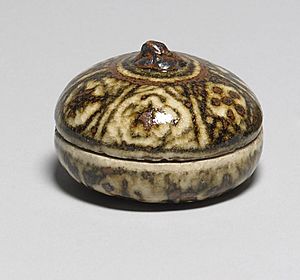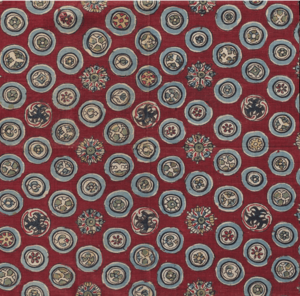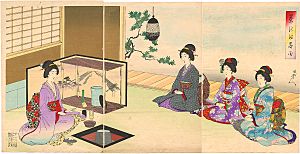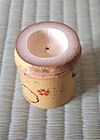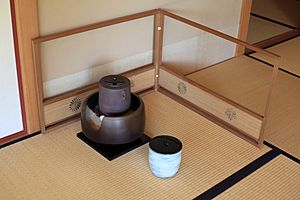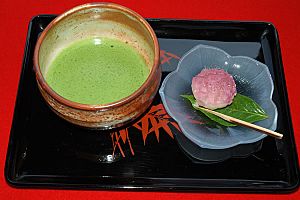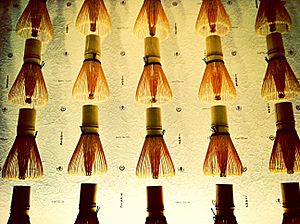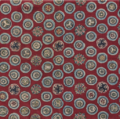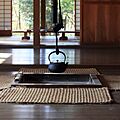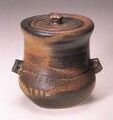Japanese tea utensils facts for kids
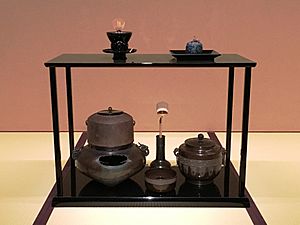
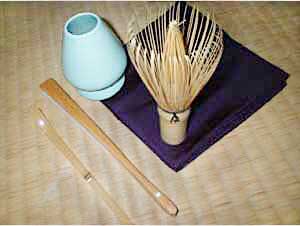
Tea utensils (known as 茶道具 (chadōgu) in Japanese) are the special tools and items used in the Japanese tea ceremony, which is a beautiful art form centered around making and serving tea.
These tools can be grouped into five main types:
- Decorative items: Things that make the tea room look nice.
- Tea-making items: Tools used to actually prepare the tea.
- Meal items: Things used for the light meal (called chakaiseki) that sometimes comes before the tea.
- Preparation room items: Tools used behind the scenes in the preparation area.
- Waiting room/garden items: Things used in the waiting area or garden before entering the tea room.
A wide variety of tools, all called dōgu, are needed for even a simple tea ceremony. Generally, `chadōgu` refers to the items a host uses to prepare and serve tea. This article will cover many of these interesting tools!
It's good to know that the tools for sencha (another type of Japanese tea) are different. They usually include a five-piece set of small cups, a small pot, and a small cup for hot water, often made of ceramic.
Contents
- Special Boxes for Tea Tools
- Charcoal and Fire Tools
- Cloth Items
- Tea Ceremony Furniture
- Hearths and Braziers
- Meal-Related Items
- Hanging Scrolls (Kakemono)
- Tea Tools by Origin
- Other Important Tools
- Pots for Boiling Water
- Sweet-Related Items
- Tea Bowls (Chawan)
- Tea Containers (Chaki)
- Tea Scoops (Chashaku)
- Trays
- Water Containers
- Water Ladles (Hishaku)
- Tea Whisks (Chasen)
- Images for kids
- See also
Special Boxes for Tea Tools
In Japan, important or cherished items are often kept in special wooden boxes. Valuable tea ceremony tools are usually stored this way. Sometimes, if a tool is very old and famous, it might have several layers of boxes to protect it: an inner box, a middle box, and an outer box.
These storage boxes are not tea tools themselves, but they are still important. The boxes for very old and special items often have writing on them that tells their history and where they came from.
Portable Tea Boxes (Chabako)
Chabako (茶箱, lit. tea box[es]) are special lidded boxes that hold a tea bowl, tea caddy, tea scoop, and other small tools. They are like portable tea sets, perfect for making tea when traveling or outdoors. They come in many different styles.
One famous type is the "rikyū model," made of plain paulownia wood. It comes in large and small sizes. The large one is about 19 cm (7.5 inches) long, 13 cm (5.1 inches) wide, and 11.5 cm (4.5 inches) high. These boxes often have an inside shelf.
Long ago, there were no strict rules for how to use these tea boxes. But later, a leader of the Urasenke tea school created specific ways to use them. For these procedures, the box is brought into the tea room, sometimes on a tray. Each item is carefully taken out of the box, used, and then put back.
Tea boxes are made of wood and can be lacquered and decorated, or left natural. There are also similar portable tea sets called chakago (茶籠, lit. tea basket[s]), where the box is made from woven bamboo.
Charcoal and Fire Tools
Ash (Hai)
Ash is commonly used in the tea ceremony, especially in the portable brazier (furo) and the sunken hearth (ro) used in cold weather.
In the tea ceremony, ash creates a protective bed for the charcoal fire. People pay great attention to the ash's quality and look. Different kinds of ash are used for different purposes. For example, "wisteria ash" is used to decorate the ash in a brazier, and "silky ash" is used in portable braziers.
Ash Container (Haiki)
A Haiki (灰器) is a shallow bowl the host uses to carry ash into the tea room for the charcoal-laying ceremony. It holds special "sprinkling ash" for braziers or "moist ash" for sunken hearths.
Ash Spoon (Haisaji)
The haisaji (灰匙) is a spatula-like tool. It's mainly used to shape the ash in the portable brazier or to sprinkle ash during the charcoal-laying process.
Charcoal (Sumi)
Sumi (炭) is the charcoal used in the tea ceremony. Most `sumi` is made from chestnut-leaved oak wood, slowly burned in a kiln. The long pieces are cut into specific lengths, depending on whether they'll be used in a brazier or a sunken hearth.
There's also a special kind of charcoal called eda-zumi (枝炭, lit. branch charcoal). It's made by charring twigs from azalea or camellia and then coating them with a lime substance made from powdered seashells. This type is used for its artistic look.
Charcoal Container (Sumitori)
The sumitori (炭斗/炭取) is the container where the host puts the charcoal and other tools for carrying them to and from the tea room. Many `sumitori` are made from woven baskets.
Charcoal Carrier (Hakosumitori)
A Hakosumitori (箱炭斗) is a charcoal container used in the preparation room. It's brought into the tea room if the charcoal in the brazier or hearth needs to be refilled. It's box-shaped, has a handle, and is usually made of mulberry wood.
Feather Brooms (Habōki)
Habōki (羽箒) are feather brooms that come in several styles. One type, made of three layered feathers, is used to dust off the portable brazier or sunken hearth during the charcoal-laying ceremony. Other feather brooms are used for sweeping the tea room itself.
Fire Chopsticks (Hibashi)
Hibashi (火箸, lit. fire chopsticks) are metal chopsticks used to handle the hot charcoal.
Incense Container (Kōgō)
A Kōgō (香合) is a small lidded container for the incense added to the charcoal fire during the ceremony. If kneaded incense is used in a sunken hearth, the container is usually ceramic. For wood chips used in a portable brazier, it's often made of lacquer or plain wood. Some `kōgō` are even made from clam shells!
Cloth Items
Tea Cloth (Chakin)
A chakin (茶巾) is a small, white, rectangular linen or hemp cloth. It's mainly used to wipe the tea bowl clean. There are two main sizes: large and small. The small one is about 30.3 cm (11.9 inches) long and 15.2 cm (6 inches) wide.
Patterned Silk Cloth (Dashibukusa)
A dashibukusa (出し帛紗) is a double-layered patterned silk cloth, about 30 cm (11.8 inches) square. It's used by some tea schools, like Omotesenke. Both the host and guests carry one, often tucked into their kimono. Guests might use it to protect tea tools when they examine them.
Silk Cloth (Fukusa)
A fukusa (帛紗) is a double-layered silk cloth, about 30 cm (11.8 inches) square. It's used for symbolically cleaning the tea scoop and tea caddy. Women also use it to handle hot kettle or pot lids. The host and assistants wear the `fukusa` tucked into their sash.
Traditionally, the host uses a new `fukusa` for a formal ceremony. `Fukusa` are usually one solid color without patterns, but there are exceptions. Different colors are used for men (often purple) and women (orange or red), for different ages, skill levels, ceremonies, and tea schools.
Wallet (Fukusabasami)
Fukusabasami are rectangular wallets, often shaped like traditional envelopes. They are used to carry personal items needed for the tea ceremony, such as special paper (kaishi), a pick for sweets, a `kobukusa`, a `fukusa`, and a fan. There are two sizes: a smaller one for women and a larger one for men. Men's wallets are usually simpler in design and color.
Small Silk Cloth (Kobukusa)
A kobukusa (古帛紗) is a cloth about 15.15 cm (5.96 inches) square. Unlike a `fukusa`, it's usually made of a rich, thick, patterned fabric. In the Urasenke school, both the host and guests carry one. If wearing a kimono, it's kept in the kimono's breast pocket. Guests not wearing a kimono might carry it in their `fukusabasami`. Guests sometimes use the `kobukusa` to protect tea tools when they examine them.
Protective Bags (Shifuku)
Shifuku (仕覆) are various types of bags used to store tea caddies (chaire) and other tea tools. They are traditionally made from silk, often with patterns. Very valuable tools were sometimes kept in bags made from rare old Chinese fabrics. `Shifuku` are closed with a silk cord called a kumihimo, tied in special ways.
Tea Ceremony Furniture
Portable Shelf Unit (Daisu)
The daisu (台子) is an original portable shelf unit used in the Japanese tea ceremony. The most formal style is the `shindaisu`, which is made of highly polished black lacquer. It has a lower board that sits on the tatami mat, with four posts supporting an upper shelf. Its width matches the width of a Kyoto-size tatami mat.
Wooden Board (Nagaita)
A nagaita (長板) is a wooden board, usually lacquered. It's used to display the main tea tools in the tea room. Its size is based on the lower board of a `daisu`.
Brazier Boards (Shikiita)
Shikiita (敷板) is the name for different kinds of boards on which the portable brazier (furo) is placed in the tea room. They come in various shapes like large, half-size, small, or round. They are made of wood and can be lacquered or decorated. There are rules about which board to use with which brazier.
Shelves (Tana)
Tana (棚), meaning "shelf" or "shelves," is a general term for different types of shelving used in tea ceremonies. They are placed on the host's mat. Each type of `tana` has its own name. The three main types are built-in shelves, suspended shelves, and portable shelves. Portable shelves are further divided into large and small units.
`Tana` are made of various woods, with the most formal style being highly polished black lacquer. Some `tana` have drawers or shelves with sliding doors. Tea tools can be placed on or in the `tana` before and after a ceremony. `Tana` are only used in tea rooms that are 4.5 tatami mats or larger.
Hearths and Braziers
Small Braziers (Binkake)
Binkake (瓶掛) are small portable braziers. They are used to heat a specific type of iron hot-water kettle called a tetsubin, which has a spout and a handle across the top.
Portable Braziers (Furo)
Furo (風炉) are portable braziers used in the tea room to heat the hot water kettle (kama) for making tea. They are usually made of ceramic or metal, though wooden ones are rare.
Sunken Hearths (Ro)
Ro (炉) are fire pits built into the floor of tea rooms. They are used in the cold season to heat the hot water kettle (kama). The frame around the top is called a `robuchi`, usually made of lacquered wood. When the `ro` is not in use, the frame is removed, and the `ro` is covered by a tatami mat, making it invisible.
Portable Hearths (Okiro)
An okiro is a portable `ro` that is placed on the floor. It's used when a room doesn't have a built-in `ro`.
Meal-Related Items
Sake Kettle (Choshi or Kannabe)
A choshi or kannabe is a kettle that looks like a teapot. It's used for warming and serving sake. These kettles can be made of iron, tin, or pottery.
Hanging Scrolls (Kakemono)
Kakemono (掛物) literally means "hanging thing." It refers to a painting or calligraphy (beautiful writing) mounted on paper or fabric, meant to be hung in the `tokonoma` alcove of the tea room. The `kakemono` is the main decoration in the tea room. Zen calligraphy works are especially valued for `kakemono` in the tea ceremony.
Tea Tools by Origin
Chinese Items (Karamono)
Karamono (唐物, lit. Tang item) is a term for high-quality tea tools, mostly ceramics, made in China. These were imported to Japan, especially during the Song Dynasty, Yuan Dynasty, and Ming Dynasty. They have been highly valued in Japan ever since.
Korean Items (Kōraimono)
Kōraimono (高麗物, lit. Goryeo item) refers to tea tools made in the Korean Peninsula, mainly during the Yi dynasty of Korea. These are sometimes compared to the Chinese `karamono` items.
Japanese Ceramics (Kuniyakimono)
Kuniyakimono (国焼物, lit. country-fired things) are ceramics made in Japan. More specifically, this term means "provincial ceramics," not including items from famous places like Kyoto or Seto.
Other Foreign Items (Shimamono)
Shimamono is a general term for tea tools made outside Japan, Korea, and China. This includes items from the Philippines (called `Ruson`), Vietnam (called `Annan`), and Southeast Asia (called `Nanban`). Some examples are a simple unglazed pottery called `Hannera` and a type of lacquerware from Thailand called `Kinma`.
Japanese Items (Wamono)
Wamono (和物) means "Japanese item." In the tea ceremony, this term is used to contrast with `karamono` (Chinese items) or `shimamono` (other foreign items).
Other Important Tools
Whisk Shaper (Chasen kusenaoshi)
A chasen kusenaoshi is a tool used to help bamboo whisks keep their shape. It's made from wood or ceramic. A wet whisk is placed on the shaper to dry, which helps it return to its original form. This tool is used in the back preparation room and is not seen during the tea ceremony itself.
Folding Fan (Sensu)
Sensu (扇子, lit. small folding fan) (also called ōgi (扇)) are carried by everyone taking part in a tea ceremony as a sign of respect. They are not opened and used for fanning. When making formal statements or showing thanks, respect, or apology, the closed fan is placed in front of you. Guests place their fans on the floor behind them for quick use. Men's fans for tea ceremony are about 18 cm (7.1 inches) long, and women's are about 15 cm (5.9 inches).
Lid Rest (Futaoki)
Futaoki (蓋置, lit. lid rest[s]) are used to rest the lid of the kettle and also the water ladle (hishaku). They can be made of bamboo, ceramic, or metal and come in many styles.
Metal Tripod (Gotoku)
Gotoku (五徳) is a metal tripod on which the kettle is placed.
Flower Containers (Hanaire)
Flowers and their containers are a very important part of the tea ceremony decorations. The simple flower arrangements used for tea ceremony are called chabana (茶花). The containers for these flowers are generally called hanaire (花入). `Hanaire` can be made of bronze, other metals, ceramics, bamboo, or woven baskets. Bamboo `hanaire` became popular with the development of `wabi-cha` (a simple style of tea ceremony). Basket `hanaire` are usually used in warmer seasons for arrangements of seasonal grassy flowers. Some `hanaire` are designed to be hung on the wall or from the ceiling.
White Paper (Kaishi)
Kaishi (懐紙) is white paper used for various purposes during the ceremony. It usually comes as a pad of paper folded in half. The name means "paper kept handy in the bosom of the kimono."
Kettle Mat (Kamashiki)
Kamashiki (釜敷) means "kettle mat." When the kettle is taken off the brazier or hearth for the charcoal-laying ceremony, it is placed on a `kamashiki`. Some are woven, some are thick paper pads, and some are bamboo (used in the preparation room).
Rinse-Water Receptacle (Kensui)
Kensui (建水) is the bowl used by the host in the tea room to collect rinse water. It's usually made of metal or ceramic. Water used to rinse the tea bowl is poured into it. It's kept out of sight as much as possible, being the last item brought in and the first removed. While necessary, it's not one of the "showpiece" items guests are expected to focus on.
Chakin Holder (Kintō)
Kintō (巾筒) is a tube or vessel used to store a chakin cloth.
Screens (Byōbu)
- Brazier Screen (Furosaki byōbu): This is a low, two-panel folding screen. It's placed in the corner of the tea-making area if the room is larger than 4.5 tatami mats.
- Boundary Marker (Kekkai): A low fence-like device used to mark the tea-making area in larger rooms or outdoors.
Pots for Boiling Water
Kettles (Kama)
Kama (釜) are pots, usually made of iron, used to heat the water for making tea.
Iron Teapots (Tetsubin)
Tetsubin (鉄瓶) are iron pots with a pouring spout and a handle that goes over the top. They are used for heating and pouring hot water during certain tea ceremonies.
Sweet-Related Items
Sweet Boxes (Fuchidaka)
Fuchidaka Omogashi (縁高五重/菓子器) are the "main sweets" served before thick tea (koicha). They might be served in `fuchidaka`, which are stacked boxes (up to five) with one lid. This is a somewhat formal way to serve sweets, and the number of boxes used depends on how many guests are present.
Sweet Picks (Yōji)
A yōji (楊枝) or kashiyōji (菓子楊枝) is a tool used for cutting and eating sweets. There are two common types: a shorter metal one and a longer wooden one called kuromoji (黒文字), named after the type of tree they are traditionally made from.
Tea Bowls (Chawan)
Chawan (茶碗) are the bowls used for making and drinking powdered green tea (matcha). They can be grouped by where they came from, who made them, their shape, or the type of tea they are meant to hold.
Tea Containers (Chaki)
Tea containers are small lidded caddies that hold the powdered green tea (matcha) for the tea-making process.
The word chaki (茶器) literally means "tea tool," but in the tea ceremony, it usually refers to the small lidded containers for `matcha` used to make thin tea (usucha).
All tea containers for thin tea can be called `usucha-ki`. These are usually made of lacquered or plain wood. A common shape is called `natsume`, so all `usucha-ki` are often loosely called `natsume`. `Natsume` and other `usucha-ki` are classified by their size or shape.
The ceramic caddies usually used for powdered green tea to make thick tea (koicha) are called chaire (茶入, lit. tea container). They can also be called `koicha-ki`. `Chaire` are classified by their origin: import (karamono), Japan (wamono), or "island-make" (shimamono). Japanese `chaire` are classified by the potter, region, or kiln. All are also classified by their shape.
Tea Scoops (Chashaku)
Chashaku (茶杓, lit. tea scoop[s]) are also called tea spoons. They are used to move the powdered tea from the tea container (chaki) into the tea bowl (chawan).
Tea scoops are typically made from a narrow, thin piece of bamboo, though some are made of wood or ivory. They are usually about 18 cm (7.1 inches) long. The first ones brought to Japan from China were made of ivory. Tea masters in Japan have traditionally carved their own bamboo `chashaku`. They also give them a bamboo storage tube and a poetic name, which is often written on the tube. The choice of `chashaku` for a tea ceremony often depends on its poetic name.
Trays
Many different styles of trays are used in the tea ceremony, including:
- Hakkebon (八卦盆): A round black-lacquered tray with mother-of-pearl designs of eight Chinese symbols.
- Yamamichibon (山道盆): A round tray with a wavy rim that looks like a mountain path.
- Yohōbon (四方盆, lit. square tray): A square tray.
Water Containers
Fresh Water Container (Mizusashi)
A mizusashi (水指) is a lidded container for fresh cold water. The host uses it in the tea room during ceremonies. The water is mainly used to refill the water in the kettle (kama) at the end of some ceremonies. `Mizusashi` are usually made of ceramic, but wooden, glass, and metal ones are also used.
If a ceramic `mizusashi` has a matching lid made of the same ceramic, the lid is called a `tomobuta`. Often, a ceramic `mizusashi` will have a custom-made lid of lacquered wood, especially if it didn't originally come with a matching lid.
The `mizusashi` is one of the main items the host chooses to create a beautiful look for the occasion. `Mizusashi` are classified by their shape, where they were made, and other features.
Water Pitcher (Mizutsugi)
A mizutsugi (水次, lit. water pourer) is a lidded water pitcher. It's used to refill the fresh water container (mizusashi) at the end of certain ceremonies.
They can be made of metal, ceramic, or bentwood. There are two main types: `katakuchi` and `yakan`. The `katakuchi` type is cylindrical, has a spout and handle, and a matching lid. It can be made of bentwood, lacquered wood, or ceramic. The `yakan` type is made of metal.
Water Ladles (Hishaku)
Hishaku (柄杓) is a long bamboo ladle with a small bump in the middle of the handle. It's used to pour hot water from the iron pot (kama) into the tea bowl. It's also used to transfer cold water from the fresh water container to the iron pot when needed.
A `tetsubin` (iron teapot with a spout) doesn't need a `hishaku`. Different styles of `hishaku` are used for different ceremonies and seasons. A larger version, made of cypress wood, is used for the ritual rinsing of hands and mouth by guests before entering the tea room. It's also used by the host in the back preparation area of the tea room and is called a `mizuya-bishaku`.
Tea Whisks (Chasen)
Chasen (茶筅) are bamboo whisks used to prepare `matcha` tea. They are carved by hand from a single piece of bamboo. They differ in style based on the type of bamboo, the shape and number of their tines (the small prongs), the thickness and length of the bamboo, and the color of the thread wrapped around the bottom of the tines.
Different schools of tea ceremony prefer different styles of `chasen`. They also use different styles depending on the type of tea or tea-preparation style. For example, there are specific styles for preparing thin tea (usucha), thick tea (koicha), and for special occasions like New Year's.
Some styles are named after famous tea masters, like the "Sen no Rikyū model" or the "Dōan-gonomi" style (attributed to Sen no Rikyū's son). These styles have continued to grow over time.
Generally, the whisk used for thin tea (usucha) has 80, 100, or 120 fine tines. These are usually carved from a flexible but strong bamboo called `kashirodake` or `madake`.
Images for kids
See also
 In Spanish: Utensilios para la ceremonia del té japonesa para niños
In Spanish: Utensilios para la ceremonia del té japonesa para niños



